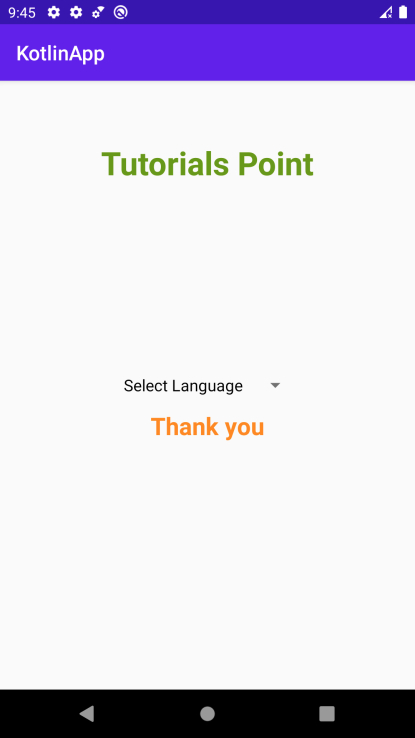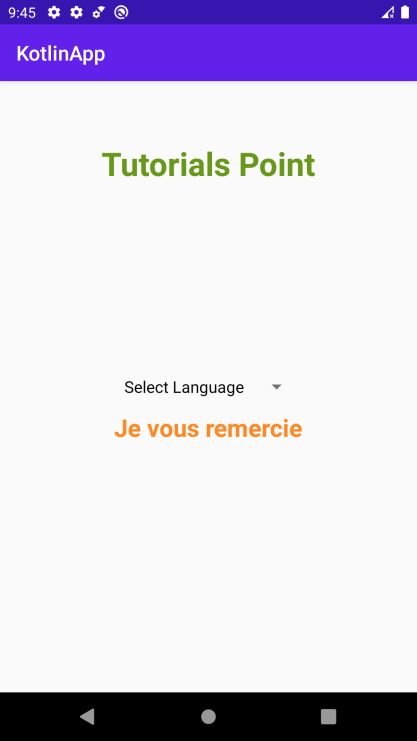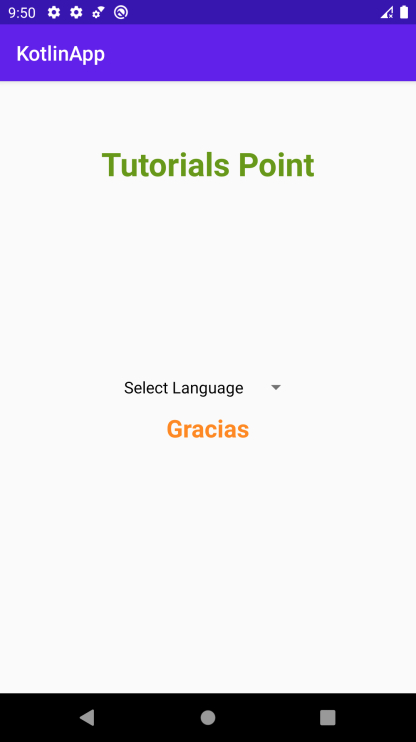
 Data Structure
Data Structure Networking
Networking RDBMS
RDBMS Operating System
Operating System Java
Java MS Excel
MS Excel iOS
iOS HTML
HTML CSS
CSS Android
Android Python
Python C Programming
C Programming C++
C++ C#
C# MongoDB
MongoDB MySQL
MySQL Javascript
Javascript PHP
PHP
- Selected Reading
- UPSC IAS Exams Notes
- Developer's Best Practices
- Questions and Answers
- Effective Resume Writing
- HR Interview Questions
- Computer Glossary
- Who is Who
How to change the language of an app when the user selects language using Kotlin?
This example demonstrates how to change the language of an app when the user selects language using Kotlin.
Step 1 − Create a new project in Android Studio, go to File ? New Project and fill all required details to create a new project.
Step 2 − Add the following code to res/layout/activity_main.xml.
Example
<?xml version="1.0" encoding="utf-8"?> <RelativeLayout xmlns:android="http://schemas.android.com/apk/res/android" xmlns:tools="http://schemas.android.com/tools" android:id="@+id/rl" android:layout_width="match_parent" android:layout_height="match_parent" android:padding="10dp" tools:context=".MainActivity"> <TextView android:layout_width="wrap_content" android:layout_height="wrap_content" android:layout_centerHorizontal="true" android:layout_marginTop="50dp" android:text="Tutorials Point" android:textAlignment="center" android:textColor="@android:color/holo_green_dark" android:textSize="32sp" android:textStyle="bold" /> <Spinner android:id="@+id/spinner" android:layout_width="wrap_content" android:layout_height="wrap_content" android:layout_centerInParent="true" /> <TextView android:id="@+id/string" android:layout_width="wrap_content" android:layout_height="wrap_content" android:layout_below="@id/spinner" android:layout_centerInParent="true" android:text="@string/thank_you" android:textColor="@android:color/holo_orange_dark" android:textSize="24sp" android:textStyle="bold" /> </RelativeLayout>
Step 3 − Add the following code to src/MainActivity.kt
import android.content.Intent
import android.os.Bundle
import android.view.View
import android.widget.AdapterView
import android.widget.AdapterView.OnItemSelectedListener
import android.widget.ArrayAdapter
import android.widget.Spinner
import android.widget.Toast
import androidx.appcompat.app.AppCompatActivity
import java.util.*
import kotlin.system.exitProcess
@Suppress("DEPRECATION")
class MainActivity : AppCompatActivity() {
lateinit var spinner: Spinner
lateinit var locale: Locale
private var currentLanguage = "en"
private var currentLang: String? = null
override fun onCreate(savedInstanceState: Bundle?) {
super.onCreate(savedInstanceState)
setContentView(R.layout.activity_main)
title = "KotlinApp"
currentLanguage = intent.getStringExtra(currentLang).toString()
spinner = findViewById(R.id.spinner)
val list = ArrayList<String>()
list.add("Select Language")
list.add("English")
list.add("Español")
list.add("Français")
list.add("Hindi")
val adapter = ArrayAdapter(this, R.layout.support_simple_spinner_dropdown_item, list)
adapter.setDropDownViewResource(android.R.layout.simple_spinner_dropdown_item)
spinner.adapter = adapter
spinner.onItemSelectedListener = object : OnItemSelectedListener {
override fun onItemSelected(parent: AdapterView<*>, view: View, position: Int, id: Long) {
when (position) {
0 -> {
}
1 -> setLocale("en")
2 -> setLocale("es")
3 -> setLocale("fr")
4 -> setLocale("hi")
}
}
override fun onNothingSelected(parent: AdapterView<*>) {}
}
}
private fun setLocale(localeName: String) {
if (localeName != currentLanguage) {
locale = Locale(localeName)
val res = resources
val dm = res.displayMetrics
val conf = res.configuration
conf.locale = locale
res.updateConfiguration(conf, dm)
val refresh = Intent(
this,
MainActivity::class.java
)
refresh.putExtra(currentLang, localeName)
startActivity(refresh)
} else {
Toast.makeText(
this@MainActivity, "Language, , already, , selected)!", Toast.LENGTH_SHORT).show();
}
}
override fun onBackPressed() {
val intent = Intent(Intent.ACTION_MAIN)
intent.addCategory(Intent.CATEGORY_HOME)
intent.flags = Intent.FLAG_ACTIVITY_CLEAR_TOP
startActivity(intent)
finish()
exitProcess(0)
}
}
Step 4 − Create values-es, values-fr, values-hi and add the following code −
values-hi/strings.xml
<?xml version="1.0" encoding="utf-8"?> <resources> <string name="app_name">Sample</string> <string name="thank_you">???????</string> </resources>
values-es/strings.xml
<?xml version="1.0" encoding="utf-8"?> <resources> <string name="app_name">Sample</string> <string name="thank_you">Gracias</string> </resources>
values-fr/strings.xml
<?xml version="1.0" encoding="utf-8"?> <resources> <string name="app_name">Sample</string> <string name="thank_you">Je vous remercie</string> </resources>
values/strings.xml
<resources> <string name="app_name">Your App Name</string> <string name="thank_you">Thank you</string> </resources>
Step 5 − Add the following code to androidManifest.xml
<?xml version="1.0" encoding="utf-8"?> <manifest xmlns:android="http://schemas.android.com/apk/res/android" package="com.example.q11"> <application android:allowBackup="true" android:icon="@mipmap/ic_launcher" android:label="@string/app_name" android:roundIcon="@mipmap/ic_launcher_round" android:supportsRtl="true" android:theme="@style/AppTheme"> <activity android:name=".MainActivity"> <intent-filter> <action android:name="android.intent.action.MAIN" /> <category android:name="android.intent.category.LAUNCHER" /> </intent-filter> </activity> </application> </manifest>
Let's try to run your application. I assume you have connected your actual Android Mobile device with your computer. To run the app from android studio, open one of your project's activity files and click the Run icon![]() from the toolbar. Select your mobile device as an option and then check your mobile device which will display your default screen
from the toolbar. Select your mobile device as an option and then check your mobile device which will display your default screen




